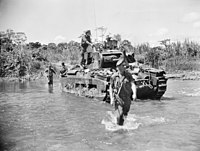
The First Australian Imperial Force was the main expeditionary force of the Australian Army during the First World War. It was formed as the Australian Imperial Force (AIF) following Britain's declaration of war on Germany on 15 August 1914, with an initial strength of one infantry division and one light horse brigade. The infantry division subsequently fought at Gallipoli between April and December 1915, with a newly raised second division, as well as three light horse brigades, reinforcing the committed units.

The 3rd Division was an infantry division of the Australian Army. Existing during various periods between 1916 and 1991, it is considered the "longest serving Australian Army division". It was first formed during World War I, as an infantry division of the Australian Imperial Force and saw service on the Western Front in France and Belgium. During this time it fought major battles at Messines, Broodseinde Ridge, Passchendaele, Amiens, and the St Quentin Canal.

The 5th Division was an infantry division of the Australian Army which served during the First and Second World Wars. The division was formed in February 1916 as part of the expansion of the Australian Imperial Force infantry brigades. In addition to the existing 8th Brigade were added the new 14th and 15th Brigades, which had been raised from the battalions of the 1st and 2nd Brigades respectively. From Egypt the division was sent to France and then Belgium, where they served in the trenches along the Western Front until the end of the war in November 1918. After the war ended, the division was demobilised in 1919.

The 57th Battalion was an infantry battalion of the Australian Army. Formed in early 1916 for service during World War I, the battalion served on the Western Front until the end of the war, when it was disbanded. In 1921, it was re-raised as a part-time unit in Victoria, known as "The Merri Regiment". In 1930, the battalion was amalgamated with the 60th Battalion, to form the 57th/60th Battalion, which remained linked until it was disbanded in 1946, after having fought against the Japanese in New Guinea and Bougainville during World War II.

The 14th Battalion was an infantry battalion of the Australian Army. Originally raised in 1914 as part of the Australian Imperial Force for service in World War I, the battalion served at Gallipoli initially before being sent to France where it served in the trenches along the Western Front until the end of the war, when it was disbanded. It was raised again in 1921 as a part-time unit of the Citizen Forces based in Victoria. Later, during World War II the battalion was called up for defensive duties to guard against possible Japanese invasion, but in late 1942 it was merged with the 32nd Battalion to become the 14th/32nd Battalion.

The 2nd Health Brigade (2HB) is an Australian Army brigade. The 2nd Brigade was formed in 1903 as a militia infantry formation based in Victoria, the brigade later served during the First World War as part of the Australian Imperial Force, allocated to the 1st Division. During the war, the 2nd Brigade took part in the fighting at Gallipoli, including the Battle of Krithia where it lost almost a third of its strength. Later they took part in the Battle of Lone Pine before being withdrawn back to Egypt in December 1915. Following this the brigade was transferred to the Western Front in France and Belgium where, between March 1916 and the armistice in November 1918, they took part in most of the major Allied operations.

The 24th Battalion was an infantry battalion of the Australian Army. Originally raised in 1915 for service during World War I as part of the 1st Australian Imperial Force, it was attached to the 6th Brigade, 2nd Division and served during the Gallipoli campaign and in the trenches of the Western Front in France and Belgium. Following the end of the war the battalion was disbanded in 1919, however, in 1921 it was re-raised as a unit of the part-time Citizens Forces in Melbourne, Victoria. In 1927, when the part-time forces adopted territorial titles, the battalion adopted the designation of 24th Battalion (Kooyong Regiment). In 1939, the 24th Battalion was merged with the 39th Battalion, however, they were split up in 1941 and in 1943, after being allocated to the 15th Brigade, the 24th Battalion was deployed to New Guinea before later taking part in the Bougainville campaign. Following the end of the war, the battalion was disbanded in 1946.
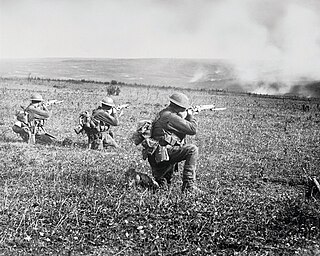
The 12th Brigade was an infantry brigade of the Australian Army. Formed in 1912 as a Militia formation, it was later re-raised in 1916 as part of the all volunteer First Australian Imperial Force that was raised for overseas service during the First World War. The brigade was part of the 4th Division and fought on the Western Front until the end of the war in November 1918. During the inter-war years, the brigade was re-formed in Australia as a part-time unit; during the Second World War, it was mobilised for full-time service, but did not serve overseas, undertaking garrison duties in Australia until 1945 when it was used to raise Timor Force.

The 57th/60th Battalion was an infantry battalion of the Australian Army which served during the Second World War. It was formed in 1930 as part of the Militia by the amalgamation of the 57th Battalion and the 60th Battalion.

The 60th Battalion was an infantry battalion of the Australian Army. It was raised for service during World War I in 1916 and took part in the fighting on the Western Front for two-and-a-half years. Following the end of the war it was disbanded before being re-raised in 1921 as a part-time unit of the Citizen Force. In 1930, as a result of manpower shortages, the 60th was amalgamated with the 57th Battalion to form the 57th/60th Battalion and this unit subsequently saw service in the South West Pacific during World War II fighting against the Japanese, before being disbanded in 1946.

The 58th/59th Battalion was an infantry battalion of the Australian Army which served during the Second World War. Raised in 1942 as part of the Militia through the amalgamation of the 58th and 59th Battalions, it formed part of the 15th Brigade, assigned to the 3rd Division. Initially the battalion undertook defensive duties in Australia before being deployed to New Guinea where it took part in the fighting around Salamaua and Lae and then the Finisterre Range campaign. In 1945 they were sent to Bougainville where they took part in the fighting in the southern sector of the island. Following the end of the war, the battalion was disbanded in 1946.

The 58th Battalion was an infantry battalion of the Australian Army. It was raised in 1916 for overseas service during World War I and saw action on the Western Front from June 1916 until the end of the war. Following the end of hostilities it was disbanded in 1919; however, in 1921 the battalion was re-raised as part of the part-time Citizens Force and remained in existence until 1942 when it was amalgamated with the 59th Battalion to form the 58th/59th Battalion. That battalion subsequently saw active service in the Pacific against the Japanese during World War II before being disbanded in 1946. After the war, the battalion was re-formed as an amalgamated Citizens Military Force unit, the 58th/32nd Battalion, which was based in Melbourne. This unit remained in existence until 1960 when it was subsumed into the Royal Victoria Regiment.

The 59th Battalion was an infantry battalion of the Australian Army. Initially raised for service during World War I, the battalion fought on the Western Front in France and Belgium between 1916 and 1918, before being disbanded in 1919. In 1921, it was re-raised as a part-time unit of the Militia in Victoria. They remained in existence until 1942 when, due to a manpower shortage in the Australian economy, the decision was made to amalgamate the battalion with the 58th Battalion to form the 58th/59th Battalion. Together they remained linked throughout World War II, serving in New Guinea and Bougainville in 1943–1945. In 1952, the 59th Battalion was re-raised and subsequently was absorbed into the Royal Victoria Regiment in 1960.

The 27th Battalion was an infantry battalion of the Australian Army. It was initially raised in 1915 as part of the all-volunteer First Australian Imperial Force for service during World War I. During the conflict, the battalion saw action briefly at Gallipoli before later fighting on the Western Front between 1916 and 1918. It was disbanded in 1919, but was re-raised in 1921 as part of the Citizens Force, which later became the "Militia". During World War II the battalion was used mainly in a garrison role until the last year of the war when it was committed to the fighting against the Japanese during the Bougainville campaign. Following the end of hostilities it was disbanded in May 1946. Between 1948 and 1965 the battalion was re-raised and disbanded a number of times before eventually becoming part of the Royal South Australia Regiment. It was disbanded for a final time in 1987, when it was amalgamated with the 10th Battalion, Royal South Australia Regiment to form the 10th/27th Battalion, Royal South Australia Regiment.

The 47th Battalion was an infantry battalion of the Australian Army. It was originally raised in 1916 for service during the First World War. The battalion then took part in the fighting in the trenches of the Western Front in France and Belgium, before being disbanded in early 1918 to provide reinforcements for other Australian units that were suffering from a manpower shortage following the German spring offensive. In 1921, it was re-raised as a part-time unit of the Citizens Force, which later became the Militia. During this time it was based in south-east Queensland and in 1927 it became known as the "Wide Bay Regiment". During the Second World War the 47th Battalion took part in fighting in New Guinea and Bougainville, before being disbanded again in January 1946. Later, the battalion was re-raised before eventually being subsumed into the Royal Queensland Regiment in 1960.

The 29th Battalion was an infantry battalion of the Australian Army. First formed in 1915 for service during the First World War as part of the Australian Imperial Force (AIF), it fought in the trenches of the Western Front in France and Belgium before being disbanded in late 1918 to provide reinforcements for other heavily depleted Australian units. In 1921, following the demobilisation of the AIF, the battalion was re-raised as a unit of Australia's part-time military forces, based in Melbourne, Victoria, before being amalgamated with the 22nd Battalion in 1930. It was later re-raised in its own right and, following the outbreak of the Second World War, undertook garrison duties in Australia before being amalgamated with the 46th Battalion to form the 29th/46th Battalion in late 1942, subsequently seeing service against the Japanese in New Guinea and on New Britain.
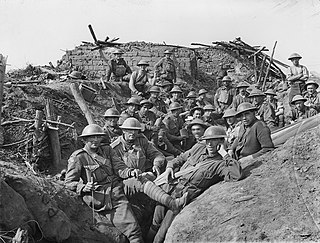
The 50th Battalion was an infantry battalion of the Australian Army. It was originally raised in Egypt in early 1916 for service during World War I, drawing a cadre of experienced personnel from the 10th Battalion. After the unit's formation, it was transferred to Europe where it took part in the fighting in the trenches of the Western Front in France and Belgium. Following the end of hostilities, the battalion was amalgamated with the 51st Battalion in early 1919 as demobilisation reduced the numbers in both battalions. In the inter war period, the battalion was briefly reformed in 1921 as a part-time unit based initially in South Australia and then later in Tasmania. At different periods it was amalgamated with both the 10th and 12th Battalions. The battalion did not see combat during World War II, being employed as garrison troops in Australia instead, and it was disbanded in mid-1945.
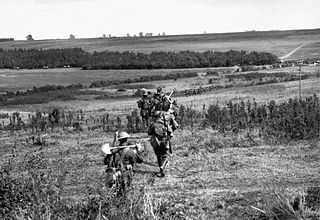
The 5th Pioneer Battalion was an Australian infantry and light engineer unit raised for service during the First World War as part of the all volunteer Australian Imperial Force (AIF). Formed in Egypt in March 1916, the battalion subsequently served on the Western Front in France and Belgium, after being transferred to the European battlefields shortly after its establishment. Assigned to the 5th Division, the 5th Pioneer Battalion fought in most of the major battles that the AIF participated in between mid-1916 and the end of the war in November 1918. It was subsequently disbanded in early 1919.

The 2nd Pioneer Battalion was an Australian infantry and light engineer unit raised for service during the First World War as part of the all volunteer Australian Imperial Force (AIF). Formed in Egypt in March 1916, the battalion subsequently served on the Western Front in France and Belgium, after being transferred to the European battlefields shortly after its establishment. Assigned to the 2nd Division, the 2nd Pioneer Battalion fought in most of the major battles that the AIF participated in between mid-1916 and the end of the war in November 1918. It was subsequently disbanded in early 1919.
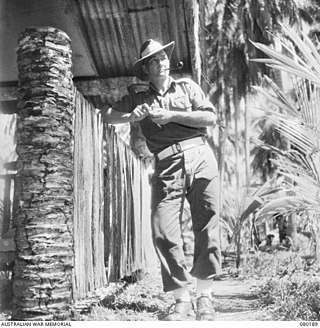
Colonel George Radford Warfe, was an Australian Army officer who commanded several Australian commando and infantry units during the Second World War. He later served in staff and training roles in the post war period, which included service during the Malayan Emergency and then as a civilian advisor during the Vietnam War following his military retirement. He was active in the civil defence organisation in Victoria and in the business community before his death at the age of 63 in November 1975 from cancer.
